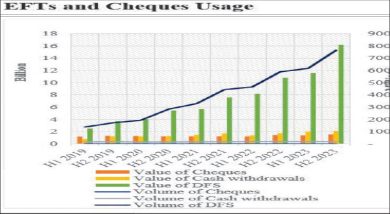Services sector growth outpaces agriculture
The services sector is registering the fastest annual growth of 1.8 percent, aaccording to an analysis, a situation commentators say reduces the economy’s over-reliance on agriculture which has become risky amid weather shocks.
An analysis by Lloyds Bank, one of Britain’s retail and commercial banks, shows that although the agriculture sector employs the largest share of Malawian workers at 61.9 percent, the economic
value of the services sector, which employs 30 percent of the workforce, far outpaces that of agriculture.
The analysis shows that the services sector contributes the most to Malawi’s gross domestic product (GDP) at 54.9 percent while the agriculture sector’s contribution stands at 21.8 percent.

In an interview yesterday, Scotland-based Malawian economist Velli Nyirongo said this entails that the services sector generates more income than the agriculture sector despite employing fewer people.
He said: “Overall, the data suggests that Malawi’s economy is undergoing a transition. The services sector is growing in importance while the agricultural sector is declining.
“The services sector is bringing more value to the GDP than agriculture. If we can scale up service, mining and manufacturing and value, we can grow the economy, but all our focus is on agriculture now. We are lacking secondary industries.”
Economists argue that despite its enormous contribution to the country’s GDP, the services sector still struggles to sprout due to slow pace of economic growth, low incomes to inadequate and unreliable power supply and corruption, little breathing space is left to exploit the sector’s potential.
Figures from Ministry of Trade and Industry show that between 1961 and 2018, the country’s economic growth has averaged 4.3 percent with most of the GDP growth over recent years coming from the services sector.
The share of services in GDP rose from 38.3 percent to 52.4 percent during the 1960 to 2017 period due to an increase in the distribution of primarily imported products from South Africa, China, India and other trading partners.
However, most of the services output involves little value-addition and job-creation.
As a consequence, the services employment only grew from 14.6 percent in 1991 to 19.9 percent in 2019.
To promote services exports to reverse the deteriorating trend and to ensure that services contribute significantly to the generation of foreign exchange, employment, incomes and poverty reduction in Malawi, the Malawi Government formulated the National Export Strategy that runs from 2021 to 2026.
The strategy was motivated by the global trends where services are playing an increasingly important role in both developed and developing economies.
Reads the strategy in part: “Sector-specific weaknesses are also discernible such as technological gaps, unprofitable social responsibilities that strangle financial sustainability of State-owned enterprises, low remuneration that fans unethical behaviours, regulated tariffs set too low to motivate investment and generally high operating costs relative to foreign competition.
“These weaknesses directly thwart the regional competitiveness of Malawi’s services.”
In an earlier interview, economist Gilbert Kachamba said the services trade is the fastest growing form of domestic and international trade and has potential to increase Malawi’s export performance





